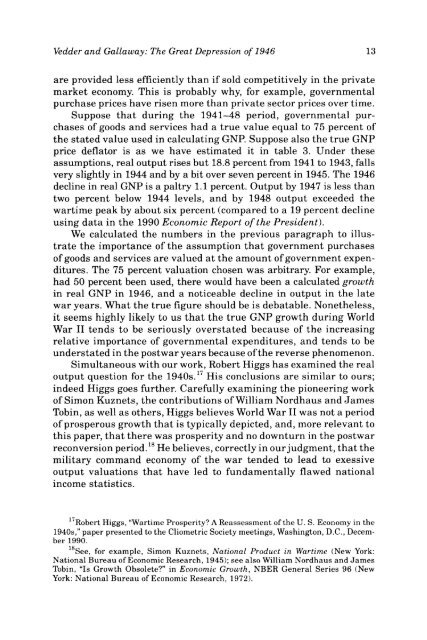Review of Austrian Economics - The Ludwig von Mises Institute
Review of Austrian Economics - The Ludwig von Mises Institute
Review of Austrian Economics - The Ludwig von Mises Institute
Create successful ePaper yourself
Turn your PDF publications into a flip-book with our unique Google optimized e-Paper software.
Vedder and Gallaway: <strong>The</strong> Great Depression <strong>of</strong> 1946 13<br />
are provided less efficiently than if sold competitively in the private<br />
market economy. This is probably why, for example, governmental<br />
purchase prices have risen more than private sector prices over time.<br />
Suppose that during the 1941-48 period, governmental purchases<br />
<strong>of</strong> goods and services had a true value equal to 75 percent <strong>of</strong><br />
the stated value used in calculating GNR Suppose also the true GNP<br />
price deflator is as we have estimated it in table 3. Under these<br />
assumptions, real output rises but 18.8 percent from 1941 to 1943, falls<br />
very slightly in 1944 and by a bit over seven percent in 1945. <strong>The</strong> 1946<br />
decline in real GNP is a paltry 1.1 percent. Output by 1947 is less than<br />
two percent below 1944 levels, and by 1948 output exceeded the<br />
wartime peak by about six percent (compared to a 19 percent decline<br />
using data in the 1990 Economic Report <strong>of</strong> the President).<br />
We calculated the numbers in the previous paragraph to illustrate<br />
the importance <strong>of</strong> the assumption that government purchases<br />
<strong>of</strong> goods and services are valued at the amount <strong>of</strong> government expenditures.<br />
<strong>The</strong> 75 percent valuation chosen was arbitrary. For example,<br />
had 50 percent been used, there would have been a calculated growth<br />
in real GNP in 1946, and a noticeable decline in output in the late<br />
war years. What the true figure should be is debatable. Nonetheless,<br />
it seems highly likely to us that the true GNP growth during World<br />
War II tends to be seriously overstated because <strong>of</strong> the increasing<br />
relative importance <strong>of</strong> governmental expenditures, and tends to be<br />
understated in the postwar years because <strong>of</strong> the reverse phenomenon.<br />
Simultaneous with our work, Robert Higgs has examined the real<br />
output question for the 1940s. 17 His conclusions are similar to ours;<br />
indeed Higgs goes further. Carefully examining the pioneering work<br />
<strong>of</strong> Simon Kuznets, the contributions <strong>of</strong> William Nordhaus and James<br />
Tobin, as well as others, Higgs believes World War II was not a period<br />
<strong>of</strong> prosperous growth that is typically depicted, and, more relevant to<br />
this paper, that there was prosperity and no downturn in the postwar<br />
reconversion period. 18 He believes, correctly in our judgment, that the<br />
military command economy <strong>of</strong> the war tended to lead to exessive<br />
output valuations that have led to fundamentally flawed national<br />
income statistics.<br />
17 Robert Higgs, "Wartime Prosperity? A Reassessment <strong>of</strong> the U. S. Economy in the<br />
1940s," paper presented to the Cliometric Society meetings, Washington, D.C., December<br />
1990.<br />
See, for example, Simon Kuznets, National Product in Wartime (New York:<br />
National Bureau <strong>of</strong> Economic Research, 1945); see also William Nordhaus and James<br />
Tobin, "Is Growth Obsolete?" in Economic Growth, NBER General Series 96 (New<br />
York: National Bureau <strong>of</strong> Economic Research, 1972).

















